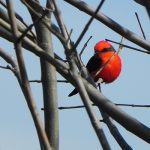Webworms generally don’t pose a threat to a tree’s survival. But if you prefer a web-free tree, there are tried-and-true ways to manage these multi-legged menaces.
Soon, ugly, nasty webworms will be insidiously attacking our pecan, mulberry and fruit trees. One day the trees are full and green and the next, sticky nests abound. How can a homeowner stop this multi-legged menace?
First of all, webworms generally don’t pose a threat to a tree’s survival. In fact, they’re more of a nuisance than anything. But if you prefer a web-free tree, there are tried-and-true ways to manage these multi-legged menaces.
But first, a little background information regarding the webworm. Native to North America, the webworm (Hyphantria cunea) is in the Lepidoptera or butterfly family. Researchers have discovered two distinct races: red-headed and black-headed. These races differ in their lifecycle, markings, food preferences and habits, but both make silk nests at the terminal branches of their host trees; although the black-headed race forms a rather flimsy web, whereas the red-headed forms one larger and more rigid.
A webworm caterpillar passes through as many as 11 developmental stages or instars. During each instar, feeding occurs within a web made of silk produced by the caterpillars. Depending on the climate, one to four generations of the webworm occur per year. The norm for the San Antonio area is generally two generations per year.
Two interesting characteristics of webworms: when alarmed all the caterpillars in a nest will jerk in unison, most likely as a defense mechanism; secondly, its common name fall webworm is an apparent misnomer.
Coming from Michigan where the caterpillar appears only in September, I learned H. cunea as the fall webworm. Upon arriving in San Antonio, however, I realized that fall webworm does not necessarily have to appear in the fall — it may appear in May or June. When scrutinizing a garden or insect reference book, just remember that the fall webworm mentioned corresponds to our June webworm.
When contemplating potential control measures, three basic alternatives come to mind:
- Ignore. This is effective and easy for two reasons. Webworms build their nest around their food supply, they don’t go looking for food. By destroying the nest, the homeowner eliminates most, if not all, the caterpillars in one fell swoop. The other reason is that webworm nests are generally located at the branch terminals of the canopy, thereby allowing you easy access to remove the infested portion.
- Release parasitical wasps the first and second weeks in May.The trichogamma wasps parasitize the webworm eggs prior to hatching. This natural treatment will diminish populations, but will not eliminate the webworm.
- You can prune out the nest and destroy the larvae.This is effective and easy for two reasons. Webworms build their nest around their food supply, they don’t go looking for food. By destroying the nest, the homeowner eliminates most, if not all, the caterpillars in one fell swoop. The other reason is that webworm nests are generally located at the branch terminals of the canopy, thereby allowing you easy access to remove the infested portion.
- Fourthly, break open the nest by either attaching a nozzle to your garden hose and blasting the nest to bits or by swatting it with a long, stout stick, pretending it’s a piñata. The nest serves as protection against predators and parasites. Once that protection is removed, the webworm’s natural enemies — wasps and birds — move in to feed.
- The last control alternative are insecticides. The most common biological insecticide is a bacterium, Bacillus thuringiensis, which is non-toxic to everything but caterpillars. Bacillus thuringiensis or Bt, liquefies a webworm’s digestive tract once the caterpillar has ingested treated leaves. Bt is distributed under several product names including Thuricide, Dipel and Bio-worm. The downside to Bt is that it lasts only three to four days and one must sacrifice the leaves. Another biological insecticide is spinosad, a naturally occurring bacterium that kills on contact. Spinosad also works well on imported fire ants, fleas and beetles. If all else fails and the tree becomes entirely infested, then we turn to a chemical based insecticide. Despite rumors to the contrary, chemical based insecticides are safe when used appropriately. Always read the label carefully. While many products exist, the two I recommend are carbaryl and pyrethrins products. Whether using biological or chemical insecticides, a qualified arborist or pest control professional should be contacted when treating large trees.
Don’t let webworms be your nightmare. I don’t lose any sleep over these creatures. Neither should you.




